High Quality Milk And How It Is Achieved
Somatic Cell Count: High quality milk comes from very healthy cows. The health of a cow can be determined by the somatic cell count (the white blood cells) in the milk. A healthy animal has a SCC of 200,000 or less per milliliter of milk. In the 1930’s, a healthy cow was considered to have 50,000 SCC or less, but as the dairy industry grew, and dairy operations became more and more industrialized, not many dairies could meet the SCC of 50,000, consequently the number was changed and is now 200,000. Keith’s dairy has consistently been between 39,000 and 50,000 over the past 15 years. Most dairy COOPs allows up to 350,000 and the State of Washington allows a maximum of 450,000 SCC (not very healthy!)
Johne’s Disease (Mycobacterium avium SSP. Paratuberculosis or MAP): A healthy cow cannot be a carrier of infectious diseases, such as Johne’s disease. This disease affects all ruminant animals, such as cattle, sheep and goats, both wild and domestic. It was first discovered in 1905 by Heinrick Johne. This is a wasting disease, similar and closely linked to Crohn’s disease in humans, and unfortunately is very common in dairy cows in many western countries. This link between Johne’s and Crohn’s is controversial. There is scientific evidence on both sides. It is a matter for every one to educate oneself about this disease and draw one’s own conclusions. Keith was concerned enough about this connection that he entered into a voluntary Johne’s testing of his entire herd. The tests were done by the Washington State Department of Agriculture. They determined that none of his animals had Johne’s. He was in this voluntary program for as long as it existed. It has since been eliminated, probably because of budget cuts. The risk of Johne’s entering Keith herd is nil, because he keeps a “closed herd,” i.e. he has not introduced outside cows or bulls for 30 years. He breeds his cows using Artificial Insemination (AI)
A2 Milk: A tiny protein fragment called beta-cosomorphin-7, or BCM7 for short, is formed from digesting a particular kind of protein called A1 beta-casing. The BCM7 is an opioid and an oxidant and has been implicated in many illnesses such as heart disease, Type 1 diabetes, and autism. Milk that is free of the A1 beta-casing is called A2 milk. All milk used to be A2 until a natural mutation affected some European breeds a very long time ago, possibly thousands of years. As a result, some areas of the world contain larger number of A1 cows. Some breeds are entirely A2 and some like the Guernsey are less then 10% A1. Finding out if ones cows have A1 is possible through genetic testing, but that is very expensive. Eliminating it from ones herd is relatively simply, through selective breeding but does take some time. Because of the expense of testing, Keith has not tested his herd, but for the last few years has only used semen from bulls that have been genetically tested and are free of the A1 beta-casing. If you want to learn more about this, a good book to start with is Devil in the Milk by Keith Woodford, professor at Lincoln University of New Zealand. The New Zealanders and the Australians are farther along in their conversion to exclusive A2 cows then we are in North America. They also appear to be more concerned about Johne’s and are actively helping farmers minimize the spread of Johne’s within their herds.
Pastures: A must in keeping cows healthy and happy is access to pasture. Keith gives his cows access to pastures whenever his fields can handle them. This includes, of course, all summer long and many days in wintertime, when weather conditions in Western Washington allow it. Even in wet Western Washington there are quite a few days the cows can go out and graze. A good quality feed is also a must. Dairy cows need to have the best feed and nothing but the best. Her body condition declines if she does not get the best. A clean environment is also important to a dairy cow, as well as a nice clean place to lie down and chew her cud. Last but not least is a knowledgeable caretaker/farmer. This person always pays attention and sees every little change in each and every cow, and knows what to do when things are not 100%. In our case we are lucky enough to have Keith Fagernes.
Pastures need to be in good condition, with the right kind of plants growing in them. The health of the soil is the base for everything, not just for the dairy cow but also for us, since we consume what she produces. The soil must be full of microbial life which makes micronutrients available to the grasses and therefore the cow, and there has to be the right balance of many nutrients and micronutrients. This is not an exact science, but a lot of science and a lot of art mixed together. Each year the soils get tested and Keith has to use his creative side to decide what to apply and when. Even the manure that gets generated on the farm cannot just be applied anywhere. Too much of one thing can throw the whole system out of balance.
Clean Milking Parlor: The milking parlor is cleaned after each milking. Not just the milking equipment but also the floor and walls are cleaned, because some cows feel the need to leave more behind than just their milk. The milkers, who stand in the pit (a lower level then the cows), are at a perfect level to receive these presents as they splatter on the floor. So the need to wash and rewash is an endless cycle. Each cow’s feet are washed as she comes in to be milked, and of course the udders are washed and sanitized, before and after they are milk. Clean cows, a clean milking parlor, and clean milking equipment are very important in preventing bacteria from entering the milk after it leaves the cow.
Awards: For many years Keith has been recognized by his peers as a very good farmer with very high standards. Keith used to joke that all these awards looked like good firewood in the middle of winter. They certainly did not help him much when it came to the bottom line. But we feel very proud to be able to put pictures of these awards here on our website. We feel it gives validity to our claim that the milk from Keith’s cows is of very high quality.
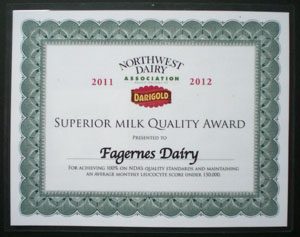
This award is given out annually by the Northwest Dairy Association. It is for Superior Milk Quality and for achieving 100% on NDA’s quality standards and for maintaining an average monthly SCC (Somatic Cell Count) of less the 150,000.
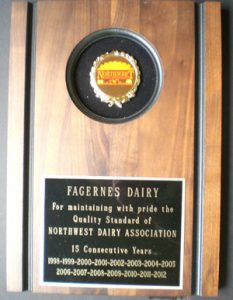
This award is also from the Northwest Dairy Association. It is given out annually. It is for maintaining with pride the Quality Standards of the Northwest Dairy Association. Keith is the only dairy with 15 consecutive years. There only 7 dairy farms that have ten or more consecutive years of maintaining the Quality Standards.
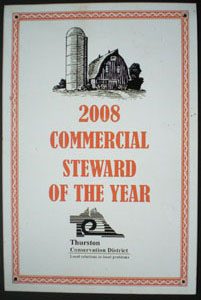
In 2008. Keith was recognized by the Thurston Conservation District for good land stewardship. This award is given out to one farm per year.
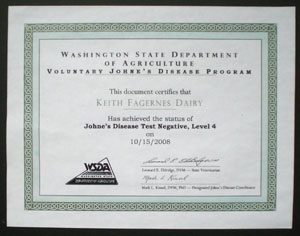
From 2004 to 2008 Washington Department of Agriculture had a voluntary Johne’s Disease testing which Keith participated in. He reached a level 4, Johne’s Disease Test Negative status, which means, in the four years they tested he had no cows with Johne’s disease.
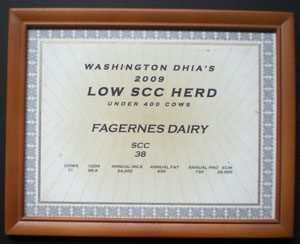
When Keith was a member of the Dairy Herd Improvement Association, he received an acknowledgment for a low SCC of 38,000. This is an award that is given out to members that have less the 400 cows. At the time Keith had 71 milking animals.
